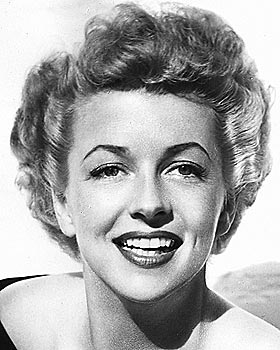Betty Furness (Elizabeth Mary Furness)

Elizabeth Mary “Betty” Furness was born in New York City, the daughter of wealthy business executive George Choate Furness and his wife Florence. Betty Furness made her stage debut in the school holidays in the title role of Alice in Wonderland. She also posed for commercial advertising. She began her professional career as a model before being noticed by a talent scout and being signed to a film contract in 1932 by RKO Studios. Her first film role was as the “Thirteenth Woman” in the film Thirteen Women (1932) but her scenes were deleted before the film’s release. Over the next few years she appeared in several RKO films, and became a popular actress. Among her film successes were Magnificent Obsession (1935) and the Fred Astaire and Ginger Rogers film Swing Time (1936). By the end of the decade she had appeared in over forty films, but during the 1940s found it difficult to secure acting roles. In 1948 Betty Furness was performing in the television series Studio One, which was broadcast live. She filled in for an actor to promote Westinghouse products during the advertisement break, and impressed the company with her easy and professional manner. They offered her a contract to promote their products and she subsequently became closely associated with them. One of television’s most recognizable series of commercials had Furness opening wide a refrigerator door, intoning, “You can be sure … if it’s Westinghouse.” (The spots were so well known they were often parodied: one Mad magazine gag imagined the words on a neon sign, with a few key letters burned out: YOU CAN ..SU.E IF IT’S WESTINGHOUSE!”)
Ironically, Furness may be best known today for a Westinghouse commercial in which she did not appear: during a live spot, a refrigerator door failed to open, creating one of the most infamous bloopers in TV history. This actually did not happen to Furness, as has often been claimed, but to another actress (June Graham), who was substituting for her. Betty Furness hosted ABC’s Penthouse Party which ran for 39 episodes from September 1950 to June 1951. Furness was a regular panelist on the CBS panel show What’s My Line? in 1951. She appeared in a series of live mysteries on ABC, under the weighty title Your Kaiser Dealer Presents Kaiser-Frazer “Adventures In Mystery” Starring Betty Furness In “Byline” which ran in November and December 1951, and again on ABC in syndication in the fall of 1957. The series was produced by the DuMont Television Network and ran on DuMont under the title News Gal. In 1953 she appeared in her own daytime television series Meet Betty Furness, which was sponsored by Westinghouse; she remained a spokesperson for the company until 1960. Her final spots for Westinghouse were seen within the CBS News coverage of the July 1960 Los Angeles Democratic Convention, the August 1960 Chicago Republican Convention and the evening of November 8th election returns. She then attempted to move into a less commercialized role in television, but found herself too closely associated with advertising to be taken seriously. During this time, she worked on radio and also on behalf of the Democratic Party.
Betty Furness has two stars on the Hollywood Walk of Fame, for her contribution to motion pictures and to television. Furness married four times. Her first marriage was to composer-conductor Johnny Green in 1937 with whom she had one child. After her divorce from Green in 1943, she married radio announcer Hugh “Bud” Ernst Jr. twice; first in 1945, and again in 1946. Her second marriage to him lasted until his death in 1950. She married again in 1967 to Leslie Midgley, who survived her. Her granddaughter is Liza Snyder, from the CBS Television series Yes, Dear. In 1990 Furness was diagnosed with cancer. She continued working for The Today Show until she was released from her contract in 1992. Her dismissal was widely publicized and controversial and was viewed by many of Furness’ supporters as ageism. Furness expressed her philosophy of never declining a job, and she believed it was the reason that she progressed through such an unconventional series of professions. During her illness, she stated that she wanted nothing more than to be able to work, and (consumer reporter to the end) once mentioned in an interview that, as far as her cancer went, “the treatment is worse than the disease,” but her health continued to deteriorate until her death in New York from stomach cancer in 1994.
Born
- January, 03, 1916
- USA
- New York, New York
Died
- April, 02, 1994
- USA
- New York, New York
Cause of Death
- stomach cancer
Cemetery
- Ferncliff Cemetery and Mausoleum
- Hartsdale, New York
- USA



